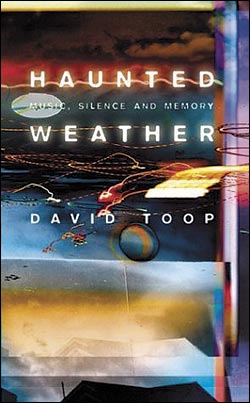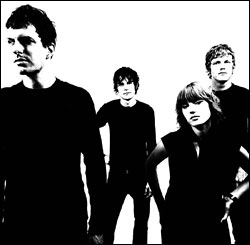Nothing changes quite like metal. True, no parametric scheme is ever quite abandoned; the relative attributes of olde and nü mingle endlessly, like fingers and fluids in Anne Rice’s Beauty trilogy. Difference is, the genre tends to mutate with more religion and a quicker assimilation trigger finger than Rice or most other nonmetal phenomena, which can lead to some pretty bizarre couplings.
Take Hella, whose roots are planted firmly in the ADD-enhanced soundtracks Carl Stalling composed for Warner Bros.’ gloriously scatterbrained ’40s cartoons. On Hold Your Horse Is and The Devil Isn’t Red (both 5RC), the Sacramento lightning calculators rip through tempos, time signatures, and moods with a breakneck abandon that makes Fantomas-mode Mike Patton seem like Steve Reich on a Robitussin bender. Hella’s 2005 double-solo debut for Suicide Squeeze, Church Gone Wild/Chirpin’ Hard, finds guitarist Spencer Seim and drummer Zach Hill splaying their spazz factor by bifurcating à la Outkast.
Seim’s Chirpin’ builds on his experience with Nintendo cover band the Advantage, largely reformatting Hella’s trick-intensive agenda for synthy rhythmic escapades that wouldn’t seem at all out of place emanating from a cartridge. On Church, Hill trades his half of the slide rule for a cauldron, whipping guitar, electronics, and drums (natch) into a seething phantasmagoria. While both discs amuse in a getting-it-out-of-their-systems sort of way, the sum of their disparate impulses in no way equals Hella’s bottomless whole.
Since 1999, the course Bostonians Isis have steered has been the direct opposite of Hella’s. Possessing the longest collective attention span in metal this side of Earth or Sunn 0))), the quintet still suffers endless comparisons to Neurosis, despite manifest affinities for the music of Mogwai, Swans, and Godspeed You! Black Emperor. So compelling is the focus of 2002’s Oceanic that on Oceanic: Remixes/Reinterpretations (Hydra Head), even aforementioned skitterbug M. Patton approaches his task as though redigging the Marianas Trench. Like Godflesh/Jesu kingpin Justin Broadrick’s elegant take on “Hym,” Patton’s juicy “Maritime” emphasizes the band’s voluptuous flow. But it’s the album’s full-on dronifications—particularly Thomas Köner’s rumble-driven “Hym” and Christian Fennesz’s diaphanous “Weight”—that rise like Osiris reborn.
Not even the mightyFennesz can beat Tod Dockstader at the drone game; his only peers in that regard are fellow septuagenarians Roland Kayn and Pauline Oliveros. The most surprising thing about Dockstader’s Aerial (Sub Rosa) is the shortwave-generated source material. It’s neither new nor special in itself; composers have been biting the ionosphere for soul at least since Alvin Lucier’s 1980 Sferics. But Dockstader’s magisterial tweaks transform mere sputters and rasps into the sorts of vast sonorities the whalelike creatures who inhabit Titan’s vast methane seas might listen to at work if they had iPods.
Given their role in pioneering phree pholk collective the Tower Recordings, it’s hardly surprising that Matt Valentine and Erika Elder leave the computers and etheric transmissions to Idea Records labelmates and veteran experimentalists “Blue” Gene Tyranny and Philip Kramm, whose excellent Formations employs a natural broadcast from the galactic south pole as background scree. Not that the younger duo’s Ragas & Blues: Fantastic String Music lacks otherworldly results; they just prefer to voyage starward in an acoustic canoe. “Where Is That Transcendental Thana” situates them midway between Mumbai and Sirius C, with plaintively alien bottleneck guitar barely keeping its head above a chittering horde of smaller vibrations.
No less adventurous but considerably more grounded is Pandit Debashish Bhattacharya‘s Calcutta Slide-Guitar (Riverboat). The former child prodigy’s orientation is strictly classical; when he plays a raga— say his own deliciously liquid “Prema Chakor”—he’s not just cutting his THC with curry powder, as per Valentine and Elder, he’s adapting 1,000 or so years of tradition to a somewhat Western instrument. Why somewhat? Therein lies Bhattacharya’s sense of adventure, or part of it: The 40-ish maestro has devoted a good chunk of his life to designing guitars especially suited for Indian music—with resonating strings, hollow necks, and whatnot. He’s also intensely interested in porting indigenous vocal mannerisms over to his ax. Hence, the slide.
The joints on Tibetan Buddhist Rites From the Monasteries of Bhutan make Bhattacharya’s seem like ska, agewise; some of their elements date back to the seventh century—or further still, if you count the influence of the country’s indigenous Bonpo religion. Captured by Jonathan Levy in 1971, released on Lyrichord in the mid-’70s, and newly reissued on a two-disc set by Sub Rosa, the field recordings offer revelations galore: Levy, whom David Toop once called “the world’s greatest ethnomusicologist,” was granted access to even the most secret ceremonies.
While the discs hardly skimp on the rich, growly overtone singing usually associated with Tibetan tantric music, other sacred instruments figure prominently— especially the long trumpets whose resonance fans of Current 93’s older work might recognize . . . sort of. Toop very well may have been right about Levy; the booklets even include lyrics. But aspiring tantric karaoke champs are advised to proceed with the utmost caution. These monks are fearless; many of the deities they commune with and demons they battle are truly nobody’s sweetheart—and there are lots and lots of them. Change or no, how fucking metal is that?








